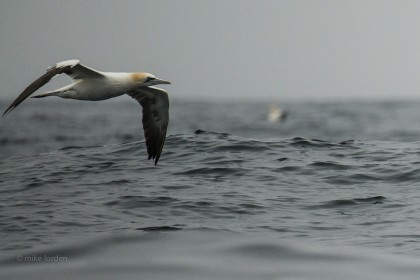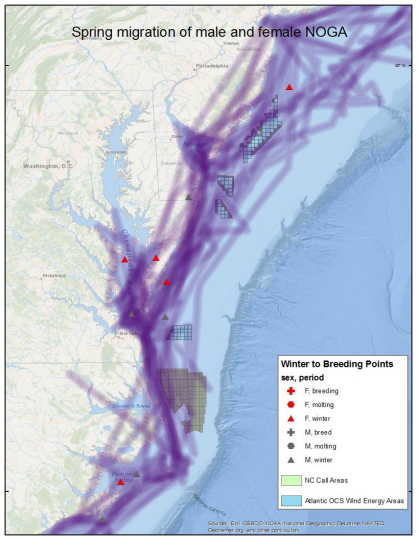
Twice a year gannets make a dramatic appearance on our coastline.
In the fall, they can be seen plunge diving in pursuit of migrating schools of fish moving south along the Atlantic Coast.
In the spring, it seems, gannet activity is particularly centered on the Delaware Bay. They appear in large numbers for a brief time in March and April before most proceed to their breeding colonies in Canada.
If you time a Cape May-Lewes ferry ride right during this time of year, the gannets create a spectacle by diving in the boat wake at close range.
The gannets’ activity in the Bay may be related to the spring migration of anadromous fish — shad, alewife and blueback herring — that move into estuaries to spawn in upstream rivers and streams.
Who are these gannets and how do the waters of New Jersey fit into the rest of their life cycle?
If it wasn’t for a recent spate of tracking research, we wouldn’t be able to offer much of an answer to this question. The Birds of North America account, written in 2002, is light on details regarding the migration of gannets.
Since then, the gaps in our knowledge have started to be filled in. Much of this research appears to be courtesy of federal dollars aimed at understanding potential risks to gannets and other birds from wind energy development.
(Credit Cristel Veefkind via Creative Commons)
One remarkable aspect of gannet distribution is that, on our side of the Atlantic, they are restricted to just six breeding colonies in Quebec and Newfoundland.
Beyond the six colonies we have on our side of the pond, there are more than three dozen colonies in northern Europe. From tracking research in Europe it appears that our two populations don’t comingle in winter. The European gannets stay on their side of the Atlantic.
The North American tracking studies tell us that after nesting season gannets spread out from the northeast U.S. down to the Gulf of Mexico. Gannet originating from the six different colonies can be found throughout the nonbreeding range. There’s evidence that the younger birds move further south, with a 12:1 ratio of young to old birds in the Gulf.
Gannets wander freely during their nonbreeding season, perhaps capitalizing on shifting foraging opportunities. According a report by the Biodiversity Research Institute which is leading some of the current tracking work, “Northern Gannets appeared to roam across the wintering area and were quite capable of moving between these core use areas on a daily basis.”
What are the “core areas” the report speaks of? Well, one of them is the Delaware Bay!
The core areas were defined based on the movements of 17 gannets. Below is a different view of the movements of the same birds during spring (Feb 23-May 1) and fall (dates not specified) migration.


We can see that both the Chesapeake and Delaware Bays, along with the Outer Banks, are important for gannets in nearly all seasons except for the nesting season. Incidentally, additional tracking research indicates that gannets do not range far from the colony during nesting season.
Gannets begin arriving at colonies in mid-April, but based on the tracking research, there are still birds lingering in the mid-Atlantic as late as mid-May. They clear out in summer and do not appear again in significant numbers at the Jersey Shore until September and October.
Thanks this new knowledge about gannet movement we can put the Delaware Bay into perspective. It really is one of the most important places for North America’s gannets, fall, winter and spring.
See what it feels like to be a gannet (my take? nauseating!).
Fly with a gannet from DaMan on Vimeo.